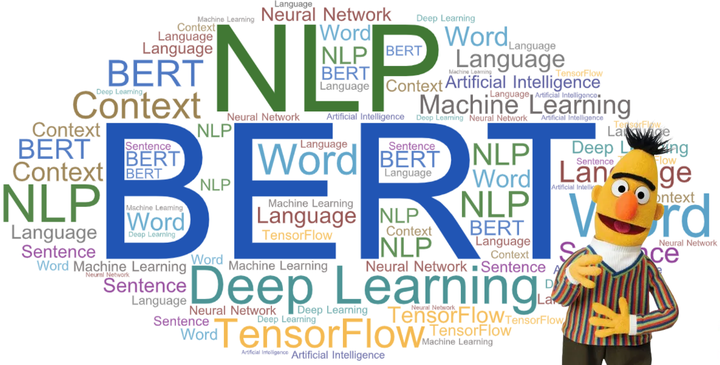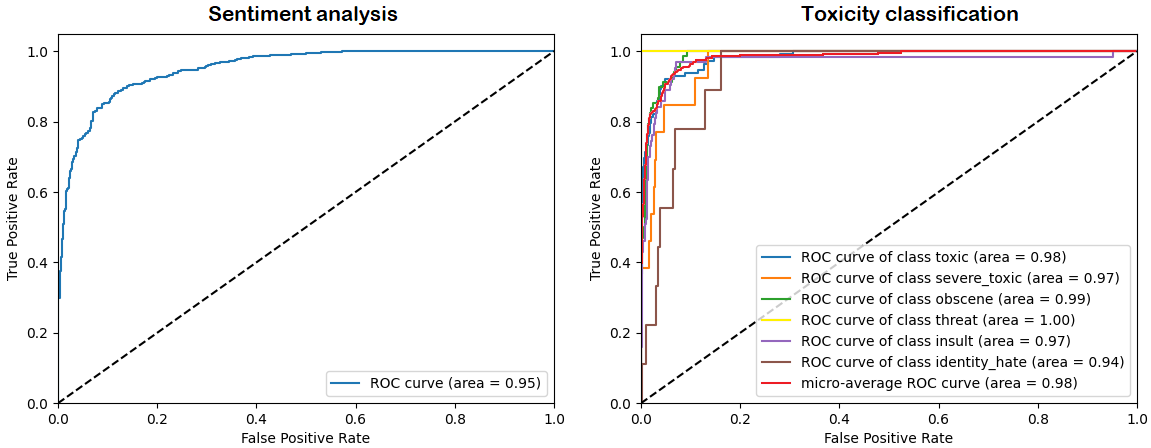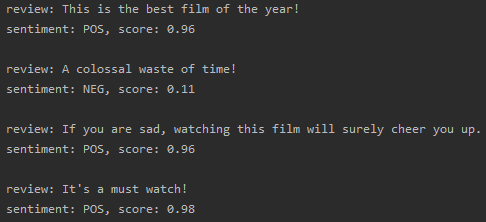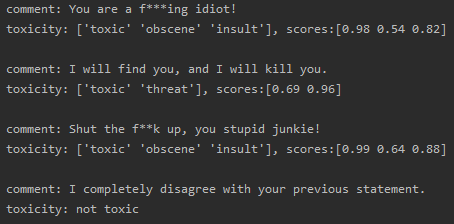Play with BERT! Text classification using Huggingface and Tensorflow
How to fine-tune a BERT classifier for detecting the sentiment of a movie review and the toxicity of a comment.

In what follows, I’ll show how to fine-tune a BERT classifier using the Huggingface Transformers library and Keras+Tensorflow.
Two different classification problems are addressed:
- IMDB sentiment analysis: detect the sentiment of a movie review, classifying it according to its polarity, i.e. negative or positive.
- Toxic comment classification: determine the toxicity of a Wikipedia comment, predicting a probability for each type of toxicity, i.e. toxic, severe toxic, obscene, threat, insult and identity hate.
What is BERT?
Bidirectional Encoder Representations from Transformers (BERT) is a Natural Language Processing Model proposed by Google Research in 2018. It is based on a multi-layer bidirectional Transformer, pre-trained on two unsupervised tasks using a large crossdomain corpus:
- Masked Language Modeling (MLM): 15% of the words in each sequence are replaced with a
[MASK]token. The model then attempts to predict the masked words, based on the context provided by the non-masked ones. - Next Sentence Prediction (NSP): the model receives pairs of sentences as input and learns to predict if the second sentence is the subsequent sentence in the original document.
BERT is deeply bidirectional, which means that it can learn the context of a word based on all the information contained in the input sequence, jointly considering previous and subsequent tokens. In fact, the use of MLM objective enables the representation to fuse the left and right contexts, allowing the pre-training of a deep bidirectional language representation model. This is a key difference compared to previous language representation models like OpenAI GPT, which uses a unidirectional (left-to-right) language model, or ELMo, which uses a shallow concatenation of independently trained left-to-right and right-to-left language models. BERT outperformed many task-specific architectures, advancing the state of the art in a wide range of Natural Language Processing tasks, such as textual entailment, text classification and question answering.
For further details, you might want to read the original BERT paper.
Fine-tuning
Let’s now move on how to fine-tune the BERT model in order to deal with our classification tasks. Text classification can be a quite challenging task, but we can easily achieve amazing results by exploiting the effectiveness of transfer learning form pre-trained language representation models. The first use case is related to the classification of movie reviews according to the expressed sentiment, which can be positive or negative. The used data come from the IMDB dataset, which contains 50000 movie reviews equally divided by polarity. The second case study is about building a model capable of detecting different types of toxicity like threats, obscenity, insults, and identity-based hate. The used dataset is comprised of a large number of comments from Wikipedia. Toxicity detection models are useful for helping online discussions become more productive and respectful.
In the following, I show my Keras code for creating the models.
def create_model(n_out):
input_ids = layers.Input(shape=(MAX_SEQ_LEN,), dtype=tf.int32, name='input_ids')
input_mask = layers.Input(shape=(MAX_SEQ_LEN,), dtype=tf.int32, name='attention_mask')
input_type = layers.Input(shape=(MAX_SEQ_LEN,), dtype=tf.int32, name='token_type_ids')
inputs = [input_ids, input_mask, input_type]
bert = TFBertModel.from_pretrained(BERT_NAME)
bert_outputs = bert(inputs)
last_hidden_states = bert_outputs.last_hidden_state
avg = layers.GlobalAveragePooling1D()(last_hidden_states)
output = layers.Dense(n_out, activation="sigmoid")(avg)
model = keras.Model(inputs=inputs, outputs=output)
model.summary()
return model
The only difference between the two models is the number of neurons in the output layer, i.e. the number of independent classes, determined by the n_out parameter.
For the first case study, n_out is equal to n_out is equal to
As we can see, the BERT model expects three inputs:
- Input ids: BERT input sequence unambiguously represents both single text and text pairs. Sentences are encoded using the WordPiece tokenizer, which recursively splits the input tokens until a word in the BERT vocabulary is detected, or the token is reduced to a single char.
As first token, BERT uses the
CLSspecial token, whose embedded representation can be used for classification purposes. Moreover, at the end of each sentence, aSEPtoken is used, which is exploited for differentiating between the two input sentences in the case of text pairs. - Input mask: Allows the model to cleanly differentiate between the content and the padding. The mask has the same shape as the input ids, and contains 1 anywhere the input ids are not padding.
- Input types: Contains 0 or 1 indicating which sentence the token is a part of. For a single-sentence input, it is a vector of zeros.
The huggingface model returns two outputs that can be exploited for downstream tasks:
- pooler_output: it is the output of the BERT pooler, corresponding to the embedded representation of the
CLStoken further processed by a linear layer and a tanh activation. It can be used as an aggregate representation of the whole sentence. - last_hidden_state: 768-dimensional embeddings for each token in the given sentence.
In this example, I used a Global Average Pooling on the sequence of all hidden states, to get a concise representation of the whole sentence. Other options are using the pooler output or directly taking the embedded representation of the CLS token before it is fed to the BERT pooler.
After the creation of the model, we can fine-tune it as follows:
def fine_tune(model, X_train, x_val, y_train, y_val):
max_epochs = 4
batch_size = 32
opt = tfa.optimizers.RectifiedAdam(learning_rate=3e-5)
loss = keras.losses.BinaryCrossentropy()
best_weights_file = "weights.h5"
m_ckpt = ModelCheckpoint(best_weights_file, monitor='val_auc', mode='max', verbose=2,
save_weights_only=True, save_best_only=True)
model.compile(loss=loss, optimizer=opt, metrics=[keras.metrics.AUC(multi_label=True, curve="ROC"),
keras.metrics.BinaryAccuracy()])
model.fit(
X_train, y_train,
validation_data=(x_val, y_val),
epochs=max_epochs,
batch_size=batch_size,
callbacks=[m_ckpt],
verbose=2
)
I trained the model for n_out output classes is modeled like a single Bernoulli trial, estimating the probability through a sigmoid activation. Moreover, I chose the Rectified version of ADAM (RAdam) as the optimizer for the training process.
RAdam is a variant of the Adam optimizer which rectifies the variance and generalization issues apparent in other adaptive learning rate optimizers. The main idea behind this variation is to apply a warm-up with a low initial learning rate, turning also off the momentum term for the first few sets of input training batches.
Lastly, I used the area under the Receiver operating characteristic curve (ROC AUC), and binary accuracy as the main metrics for validation and testing.
Training epochs
In the following, the results of the 4 training epochs of both models are shown:
Sentiment analysis, IMDB movie reviews

Toxicity detection, Wikipedia toxic comments

Results
I evaluated the trained models using
| Test BCE loss | Binary accuracy | ROC AUC | |
|---|---|---|---|
| Sentiment classification | 0.26 | 0.88 | 0.95 |
| Toxicity classification | 0.05 | 0.98 | 0.94 |
As we can see, the easy use of a fine-tuned BERT classifier led us to achieve very promising results, confirming the effectiveness of transfer learning from language representation models pre-trained on a large cross-domain corpus.
To better analyze the performance of the trained classifiers, ROC curves for both models are provided:
 We can clearly see the high confidence of both models, especially for what concerns the toxicity classifier which achieved a micro-average ROC AUC of
We can clearly see the high confidence of both models, especially for what concerns the toxicity classifier which achieved a micro-average ROC AUC of
Just to make it more fun, I wrote some sentences to further test the performance of both models.
Sentiment analysis, IMDB movie reviews

Toxicity detection, Wikipedia toxic comments

Good job! 👏👏 The first model correctly classified the polarity of all movie reviews, even in the presence of sarcasm (look at the last review).
On the other hand, the second model detected correctly the presence of toxicity in Wikipedia comments or its absence (last comment). It also determined the right types of toxicity, like obscene, toxic and insult for the first and the third comments, or threat for the second one (yes, that’s a Liam Neeson quote…I couldn’t resist! 😆).
You can find the full code and results on GitHub at this link.